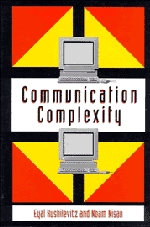2 - More on Covers
Published online by Cambridge University Press: 05 November 2009
Summary
In Chapter 1 we saw that every communication protocol induces a partition of the space of possible inputs into monochromatic rectangles and learned of two lower bound techniques for the number of rectangles in such a partition. In this section we study how closely these combinatorial measures relate to communication complexity and to each other.
Covers and Nondeterminism
Although every protocol induces a partition of X × Y into f-monochromatic rectangles, simple examples show that the opposite is not true. In Figure 2.1, a partition of X × Y into monochromatic rectangles is given that do not correspond to any protocol. To see this, consider any protocol P for computing the corresponding function f. Since the function is not constant, there must be a first player who sends a message that is not constant. Suppose that this player is Alice. Since the messages that Alice sends on x, x′ and x″ are not all the same, there are two possibilities: (1) her messages on x and x′ are different. In this case the rectangle {x, x′} × {y} is not a monochromatic rectangle induced by the protocol P; or (2) her messages on x′ and x″ are different. In this case the rectangle {x′, x″} × {y″} is not a monochromatic rectangle induced by the protocol P. Similarly, if Bob is the first player to send a nonconstant message, then this message is inconsistent with either the rectangle {x} × {y′, y″) or with the rectangle {x″} × {y, y′}.
Information
- Type
- Chapter
- Information
- Communication Complexity , pp. 16 - 27Publisher: Cambridge University PressPrint publication year: 1996
